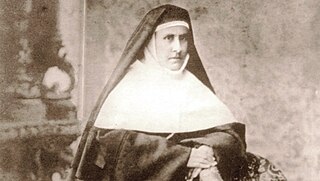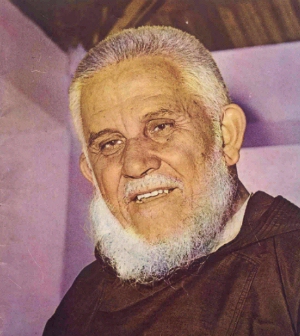Related Research Articles
Gioacchino La Lomia - born Gaetano La Lomia, religious name Gioacchino Fedele da Canicattì - was an Italian Roman Catholic priest and a professed member from the Order of Friars Minor Capuchin. La Lomia served as part of a papal-commissioned mission to Brazil where he dedicated himself to works of evangelization and the preservation of culture. He was a noted preacher and served as a confessor to Emperor Pedro II.

Benedetta Cambiagio Frassinello was an Italian Roman Catholic professed religious and the founder of the Benedictine Sisters of Providence. Frassinello married to appease her parents in 1816 but the couple decided to lead a chaste life and both pursued a call to the religious life with Frassinello joining the Ursulines in Capriolo at Brescia. But husband and wife later reunited after setting out to establish schools for the education of girls and the pair moved back to Genoa where she founded her order in 1838 based on the Benedictine charism.

Maria Domenica Mantovani was an Italian Roman Catholic professed religious, and the co-founder of the Little Sisters of the Holy Family; she established them alongside Giuseppe Nascimbeni. As a nun she received the religious name of Maria of the Immaculate.
Giovannina Franchi was an Italian Roman Catholic professed religious and the founder of the Suore Infermiere dell'Addolorata. Franchi was engaged for a brief period of time and the death of her fiancé prompted her to review her life and what her religious convictions were telling her to do; she had been involved in countless charitable works in the past and so dedicated herself to the care of the ill. Her order became tasked with aiding the ill across Como and the smallpox epidemic in 1871 thrust them into action though later claimed Franchi's life sometime later.
Maximiano Valdés Subercaseaux - in religious Francisco - was a Chilean Roman Catholic prelate who was a professed member from the Order of Friars Minor Capuchin and served as the first Bishop of Osorno from 1956 until his death. Valdés discerned his call to the priesthood while with his parents in Europe and was ordained as a priest in Venice after completing his studies in Rome but continued further formation amongst the Franciscans in Europe before making his return to Chile. He was the first Chilean to have become a Capuchin friar. Valdés dedicated his episcopal career to the poor and he often visited the poor regions around his diocese while remaining a staunch advocate for a peaceful resolution to the Chile-Argentina border disputes; his last words also contained a desire for there to be peace between the two feuding nations.

Maria Karłowska – in religious Maria of Jesus Crucified – was a Polish Roman Catholic professed religious and the founder of the Sisters of the Divine Shepherd of Divine Providence. Karłowska worked with poor and abandoned people with an emphasis on girls and also tried to aid prostitutes avoid such a life and build another kind of life so used her order to reach out to such people to render assistance.
Antonia Maria Verna was an Italian Roman Catholic religious sister and the founder of the Suore di carità dell'Immacolata Concezione. Verna left her hometown when she was fifteen due to increasing offers of marriage and returned sometime later when she decided to pursue her religious vocation. Her emphasis was on catechism and founded her religious congregation to better teach catechism to children as well as to tend to ill people.

Marta Anna Wiecka was a Polish Roman Catholic nun of the Vincentian Sisters. She assumed the name of "Maria" upon taking her vows. Wiecka worked throughout her life as a nurse in various hospitals in both Poland and in the Ukraine.
Elisabetta Maria Satellico – in religious Maria Crocifissa – was an Italian Roman Catholic professed religious from the Poor Clares who served as her convent's abbess.
María Guggiari Echeverría, OCD, religious name María Felicia de Jesús Sacramentado,, was a Paraguayan Discalced Carmelite] who also served in her adolescence as a member of Catholic Action. Echeverría entered the Carmelite order despite the opposition of her parents.
Vicenta Chávez Orozco, also known by her religious name María Vicenta de Santa Dorotea, was a Mexican Roman Catholic nun and the founder of the Servants of the Holy Spirit and the Poor. Orozco was admitted into a hospital in Guadalajara with pneumonia and there experienced a radical call to help others in the same hospital who were ill - she recovered and soon returned to fulfil this promise while later becoming a religious and establishing her own order in order to advance this mission.
María Antonia Bandrés Elósegui was a Spanish Roman Catholic professed religious from the Daughters of Jesus. She lived a brief life but was noted for her ardent faith and her Marian devotion while also being known for the effect she had on the faithful as well as agnostics whom she came into contact with.
Maria Gargani, religious name Maria Crocifissa del Divino Amore,, was an Italian member of the Secular Franciscan Order and the founder of the Sisters Apostles of the Sacred Heart. Gargani was involved with Catholic Action during her teaching career but is best known for having been a close friend and correspondent with Pio from Pietrelcina from World War I until the saint's death in 1968; the saint wrote a total of 67 letters to Gargani during this period.

Antonio Pietro Cortinovis - in religious Cecilio Maria da Costa Serina - was an Lombard Roman Catholic professed religious from the Order of Friars Minor Capuchin. He had set his heart on entering the religious life despite his initial reluctance due to him pondering on his unworthiness. This belief manifested in his childhood which motivated him to decide against entering the priesthood. But his religious formation in the order was pushed back due to World War I and he was unable to make his solemn religious profession until the war had concluded.
Mariantonia Samà was an Italian Roman Catholic. Samà lived alone with her mother until 1920 aiding her in domestic duties while coping with their poor state due to her father's death before Samà was born. But drinking unsafe water after working in the fields caused great infirmities and often-violent convulsions that the populace believed her to be possessed. In the town lived a baroness who organized for her to be taken to a Carthusian convent to be exorcised but this failed. Samà was healed after the convent's prior put her in front of a statue of Saint Bruno of Cologne and lived in relative peace for a while before being bedridden with another illness that she never recovered from.

Camila Rolón - in religious Camila of Saint Joseph - was an Argentine Roman Catholic professed religious and the founder of the Poor Sisters of Saint Joseph. Rolón survived a cholera outbreak in Buenos Aires in the 1870s that claimed her mother and brother and after this made two failed attempts to enter the Capuchin Poor Clares and the Carmelites. In 1880 she moved to Mercedes where she founded an orphanage that would later evolve into a religious congregation. Her order spread to the point that the motherhouse relocated to Rome as did she and it was there that she died.

Damião de BozzanoO.F.M. Cap., born as Pio Giannotti, was an Italian Roman Catholic priest and a professed member from the Order of Friars Minor Capuchin who served in the Brazilian missions for over six decades. Giannotti entered the order when he was twelve to do his ecclesial studies and religious formation of which he spent some of that time in Rome. He worked as a teacher from 1928 until 1931 when he was sent to the missions in Brazil. He would remain there for the rest of his life and would go travelling often to northern Brazilian cities where he would celebrate Mass and evangelize while hearing confessions on a frequent basis.
Gaetana Tolomeo - also known as Nuccia - was an Italian Roman Catholic. Tolomeo went through her entire life either confined to her bed or in a chair due to a progressive paralysis that rendered her disabled. Throughout her life she gained a reputation for her piousness and the messages of the Gospel she sought to spread to others while a guest on a local radio station from 1994 until her death. Her time on the radio station marked her interest in reaching out for the conversion of sinners with an emphasis on reaching out to prostitutes or families in need.

Francesco Maria di Francia was an Italian Roman Catholic priest and the founder of the Capuchin Sisters of the Sacred Heart. He formed a close bond with his older brother and the two studied together under a priest uncle. He tried music after experiencing doubts about his vocation but continued his studies leading to his ordination in Messina where he would spend his entire life ministering to people. He aided the ill during a cholera epidemic while in 1908 aiding in rescue and reconstruction efforts following a violent earthquake. Di Francia also taught moral theological studies to seminarians for a time before being given a role in archdiocesan curial affairs some months before his death from a heart attack.
Vincenzo Lipani - in religious Angelico - was an Italian Roman Catholic priest and a professed member from the Order of Friars Minor Capuchin who founded the Franciscan Sisters of the Lord. Lipani settled on the religious life but later joined the Franciscans after his parents relented; he did his religious formation as well as his theological and philosophical studies in Palermo where he was ordained in 1865. But new legislation forced religious orders to dissolve and he instead began to serve as a teacher in Caltanissetta for over two decades before being given a parish church to renovate and act from. He later was able to help restore his order in the region and founded a religious congregation dedicated to tending to the poor.
References
- 1 2 3 4 5 6 7 8 "Venerable Maria Costanza Panas, Capuchin Poor Clare". Ordo Fratrum Minorum Capuccinorum. 6 December 2016. Retrieved 19 March 2019.
- 1 2 3 4 5 6 7 8 "Venerabile Maria Costanza (Agnese Pacifica Panas)". Santi e Beati. Retrieved 19 March 2019.
- 1 2 "Venerable María Costanza Panas, clarisa Capuchina". Capuchin sisters - Our Lady of Light Monastery. 22 November 2018. Retrieved 19 March 2019.
- 1 2 3 "Maria Costantia Panas (1896-1963) (N. Prot. 1422)". Ordo Fratrum Minorum Capuccinorum. 7 January 2015. Retrieved 19 March 2019.